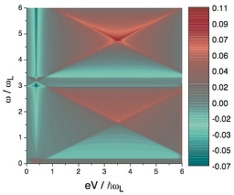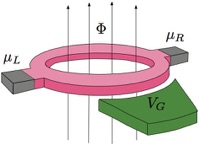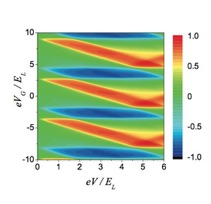

Fabrizio Dolcini

Electron Noise in mesoscopic devices
Electronic Noise: When a conductor is enclosed in a circuit, the electron current flowing through it exhibits fluctuations in time, even when the applied bias is constant. The frequency spectrum of the current-current fluctuations
is called the noise spectrum:
where ω is the frequency, V is the applied voltage, and Δj = j -⟨j⟩ is the fluctuation of the electron current operator j.
In collaboration with B.Trauzettel (Wuerzburg), I.Safi (Orsay), and H.Grabert (Freiburg), the current noise of a quantum wire capacitively coupled to a metallic gate has been investigated. In particular, it has been found out that, under suitable conditions, the noise at finite bias can be lower than the equilibrium noise, yielding a negative excess noise.
SEX(ω;V) = S(ω;V) - S(ω;V=0) excess noise
This effect has been analyzed in different regimes of the capacitive coupling to the gate, band dispersion relation and impurities in the wire.
Applied techniques
Scattering Matrix Formalism, Noise theory, Luttinger Liquid Theory




References
-
F.Dolcini and H. Grabert, Tuning Excess Noise by Aharonov-Bohm interferometry, Chem. Phys. 375, 291 (2010).
F. Dolcini, B. Trauzettel, I. Safi, and H. Grabert, Negativity of the excess noise in a quantum wire capacitively coupled to a gate, Phys. Rev. B 75, 45332 (2007).
F. Dolcini, B. Trauzettel, I. Safi, and H. Grabert, Transport properties of single channel quantum wires with an impurity: Influence of finite length and temperature on average current and noise, Phys. Rev. B 71, 165309 (2005).

